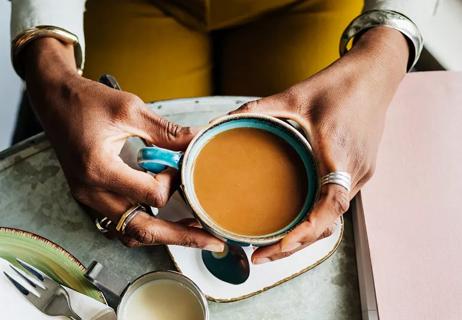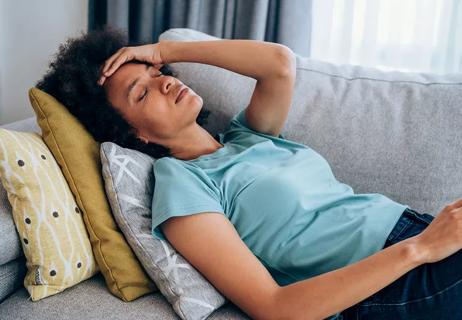Among the options is a fast-acting medication that offers relief in as little as 15 minutes

Migraines can disrupt your life. The pulsing, pounding pain in your head, along with other symptoms like nausea, fatigue, dizziness and sensitivity to light, noise and smells can make it difficult to accomplish daily activities like work and household chores, and even having a social life.
Advertisement
Cleveland Clinic is a non-profit academic medical center. Advertising on our site helps support our mission. We do not endorse non-Cleveland Clinic products or services. Policy
And while there are many ways to stop a migraine once it starts, most abortive migraine medications take a while to work — leaving you to navigate a world of pain and discomfort until the medicine kicks in.
If you’ve considered a nasal spray for migraines, there’s a promising new option called zavegepant (brand name Zavzpret®) that works as a fast-acting abortive medication.
Headache specialist Emad Estemalik, MD, explains how nasal sprays for migraines work and why you may want to consider using one to stop your migraines in their tracks.
There are a few different nasal sprays for migraines — and all of them work as an abortive medication, which means they’re designed to lessen symptoms you have during a migraine attack.
Current nasal spray options include:
A newer type of migraine nasal spray was recently approved by the U.S. Food and Drug Administration (FDA). Zavegepant is the first calcitonin gene-related peptide (CGRP) receptor antagonist nasal spray of its kind. And it works differently than other nasal sprays to combat migraines.
“CGRPs inhibit vasodilation, which is the dilatation of blood vessels,” explains Dr. Estemalik. “This newer nasal spray aborts the migraine from occurring or it aborts the migraine from progressing when you take it after the onset of a migraine.”
Advertisement
And the results seem promising, he adds. A recent study shows that zavegepant is a fast-acting drug that starts working within 15 minutes of use. And that’s in part due to the fact that your nasal passages have a lot of small blood vessels that help absorb the medication quickly.
Dr. Estemalik says you should only use a migraine nasal spray in one nostril — even if you feel pain on both sides of your head.
“A lot of people have one-sided migraine, but some have pain on both sides. If your headache is only on the right side or on the left, you should absolutely go ahead and inject the nasal spray on that side,” he says. “But if it’s both sides, it doesn’t really matter — you only need one spray.”
To do so, you want to tilt your head back about 30 to 45 degrees and then inject the nasal spray.
“By doing so, you achieve better absorption,” notes Dr. Estemalik. “One thing I prepare my patients for is that there’s an occasional bad taste with some of these nasal sprays.”
You also want to wait a few seconds for the nasal spray to get absorbed into your bloodstream before you tilt your head back down.
And while zavegepant usually offers pain relief within 15 minutes, Dr. Estemalik says you can use the nasal spray again within a 24-hour period. But he stresses you shouldn’t take more than two sprays in 24 hours.
“The vast majority of people should be pain-free within two to four hours,” he adds.
If you’ve tried other types of medication with no relief, zavegepant may be an option for you. Dr. Estemalik says that it’s also helpful for people whose migraines come on rather quickly.
“For some, they can feel a migraine coming on and then within a few minutes, it becomes a full-blown migraine with nausea, vomiting and sensitivity to light and sound,” he relates. “And zavegepant is ideal for people who have fast and quick onset of migraines.”
And if you have a heart condition or cardiovascular risk factors, CGRPs may be a better option than triptans.
It’s also a good option if you have trouble swallowing pills or become nauseated by other migraine medication.
There are a lot of upsides to considering a nasal spray to treat and stop your migraines.
Zavegepant may potentially cause nausea — and some people may not be able to adapt to the taste. Overall, Dr. Estemalik says that zavegepant doesn’t have any major drug interactions.
So, how do you know if a nasal spray for migraines is right for you?
Your healthcare provider can help make that determination, as well as help you navigate the world of insurance. Dr. Estemalik says that many insurance companies will not cover some of these newer migraine medications unless you can show that other options haven’t worked.
Advertisement
“Zavegepant is a great option and adds to the arsenal of medications that we now have for the management of either preventing or avoiding migraine,” Dr. Estemalik reinforces. “Having options that work makes a big difference for a lot of people.”
Advertisement
Learn more about our editorial process.
Advertisement

Start by reevaluating your triggers and lifestyle factors, but also consider trying new medication

A little can help, too much can hurt

They might look cool, but there’s no scientific evidence that daith piercings ward off pain

Getting enough sleep, avoiding dietary triggers and reducing stress can provide relief

Your genes may offer some insight when learning about your migraine symptoms

Migraine length depends on your triggers, health history and whether they are chronic

If you’re experiencing the worst headache of your life, it may be time for a trip to the hospital

Learn the pros and cons of CGRP inhibitors

Babies can get congested easily, but you can calm their cough by keeping them hydrated, using nasal drops and running a humidifier

Weight loss may cause loose, sagging skin and muscle loss to your rear

Several conditions, like vitiligo and fungal infection, can cause a loss of pigmentation, leading to white spots or patches on your skin